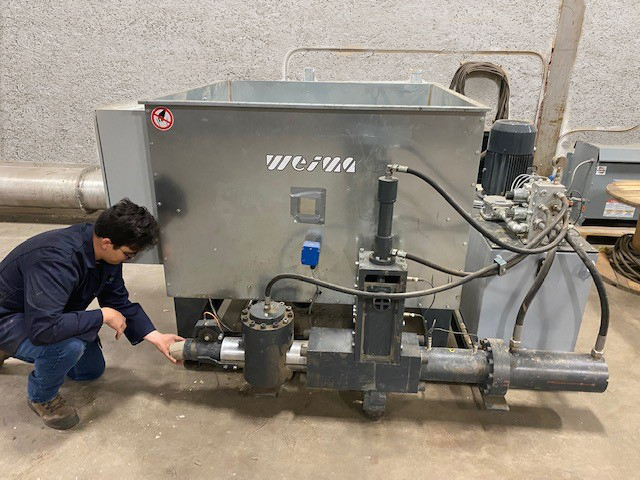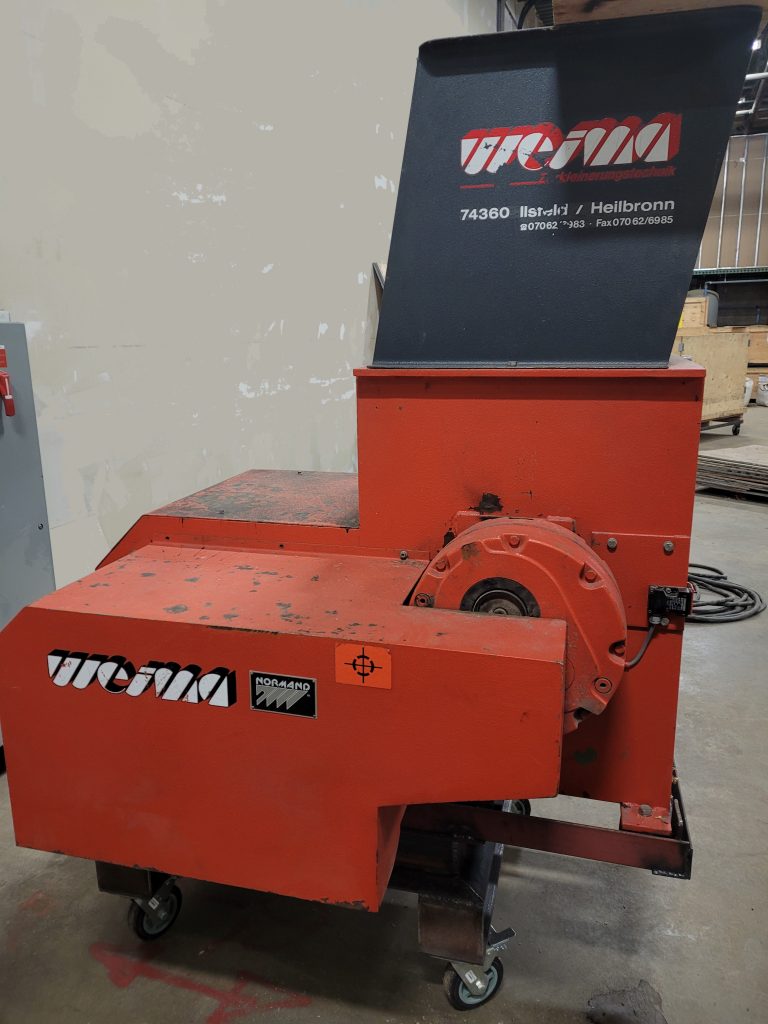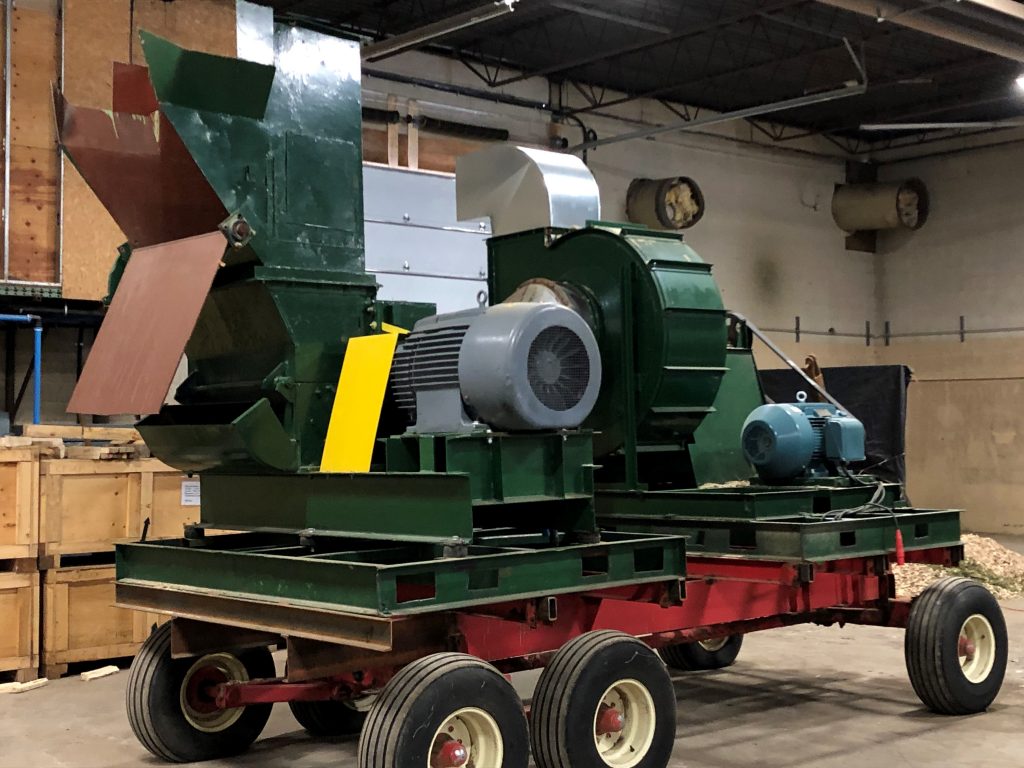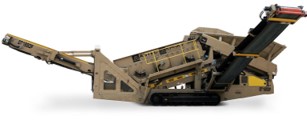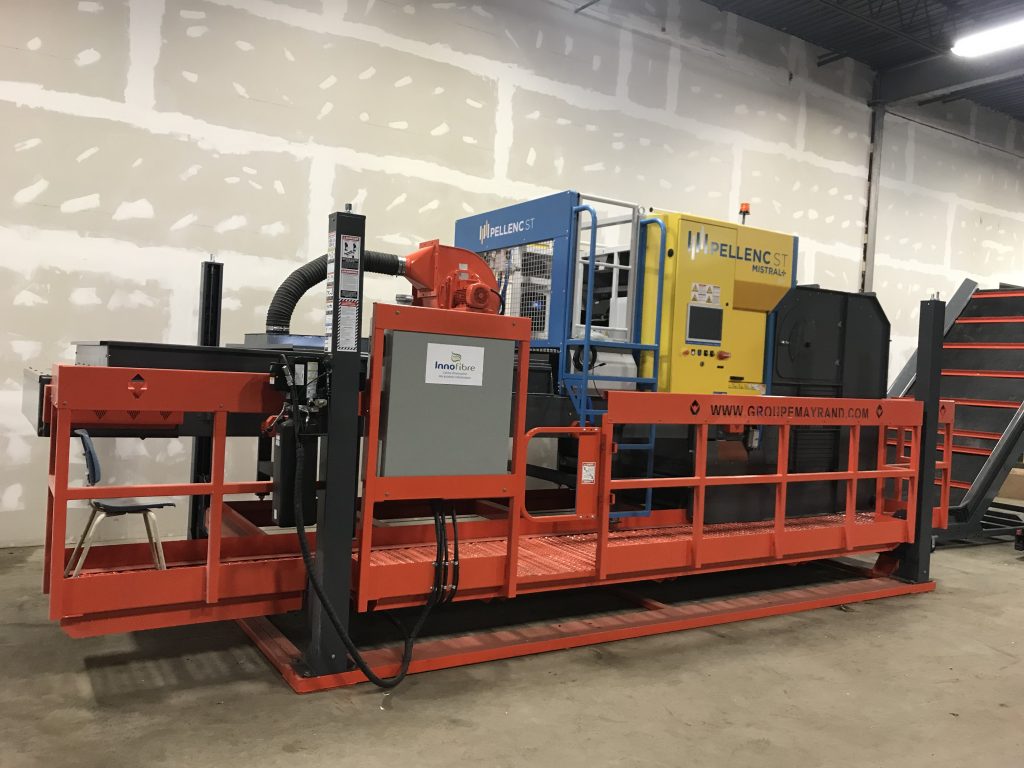Our equipment
Biomass Conditioning
The transformation and conversion of residual biomass goes through a pre-treatment sequence designed to homogenize their physico-chemical properties and improve their potential for substitution to virgin source inputs. It is common practice in the industry to encounter a combination of several processes designed to condition forestry, agricultural, municipal and urban residues for any given vocation. Innofibre’s pilot plant houses most of the equipment dedicated to this sector.
Hammermil
Characteristics
- Milling and attrition of forest, residual or inorganic fillers according to different sieving grids
Particularities
- Hammer grinding at 3,600 RPM
- Sieving screens from 20 mm to 2 mm
- 55 HP motor and integrated cyclone
Uses
- The Hammermill type hammer mill allows the fractionation of different bio-based or inorganic materials in order to obtain a more uniform particle size at the end of the process. The fan and cyclone separates fines and dust to collect the right material at the bottom of the cyclone.
Technical specs
- Manufacturier : Radviliskis
- Type: Hammer Mill 55
- Engine: 55 HP
- Diameter of the sieves: 72 cm
- Throughput: ±500 kg/hour (depending on the material
Rodrigue Hammer Mill
Characteristics
- Fractionation of forest, residual or inorganic fillers according to different sieving grids
Particularities
- Hammer grinding at 1,800 RPM
- Sieving grids from 20 mm to 6 mm
- 125 HP motor and integrated cyclone
Uses
- The Rodrigue hammer mill makes it possible to split different bio-based or inorganic materials in order to obtain a more uniform particle size at the end of the process. The fan and cyclone separates fines and dust to collect the right material at the bottom of the cyclone.
Technical specs
- Manufacturer: Rodrique
- Type: Hammer Mill LV 410 -30
- Engine: 125 HP
- Diameter of the sieves: 75 cm
- Throughput: ± 1 ton/hour (depending on the material)
Weima Pusher Slow Mill
Characteristics
- Material Splitting According to Different Sieving Grids
Particularities
- Slow grinding at approx. 100 RPM
- Sieving grids from 20 mm to 6 mm
- 10 HP motor and integrated pusher
Uses
- The slow mill is useful for splitting different bio-based or inorganic materials to achieve a more uniform particle size at the end of the process. The pusher avoids bridging the material to ensure constant flow rates of around 300 kg/hour.
Technical specs
- Manufacturier : Weima
- Type: Pusher Slow Crusher WL6S 30
- Engine: 10 HP
- Sieve diameter:Available grids: 19 mm; 6 mm
![]()
Crusher – crumbler
Characteristics
- Attrition of particles into homogeneous fines
Particularities
- 2 independent entrances with different teeth (straight and angular)
- Precise adjustment of the tooth rollers
- Attrition from coarse to ultra fine (± 1000 um)
Uses
- Attrition de granules en particules fines sans générer de poussière importante
- Réduction des grains en farine
Technical specs
- Manufacturier : Millpro
- Type: Low Dust Crumble
- Engine: 11 HP
- Flow rate: ± 100 kg/hour
Trommel-type rotary screener
Characteristics
- Three-section, variable-angle screening and separation unit
Particularities
- 3 Programmable heating elements
- Temperature control up to 1000 °C
- Gas capture and analysis capability
Uses
- Separation of heterogeneous materials through three separate screens continuously. The material is transported by a feed auger to the sieving surface where a high-speed rotor forces the particles of the desired particle size through three grids.
Technical specs
- Manufacturier :LMM
- Type: TR60 lump breaker
- Throughput: ± 100 kg (depending on grain size)
- Sieve diameter: 46 cm
Belt dryer
Characteristics
- Natural Gas Belt Dryer
Particularities
- Two drying compartments with variable temperature up to 150 °C
Uses
- The biomass dryer is used with any type of biomass that requires thermal conditioning
Technical specs
- Manufacturier : Airex industries
- Type: Belt dryer
- Speed: Speed adjustable between 0.1 to 1.75 RPM
- Specifications: Two Maxon Ovenpack 425 fireheads with a capacity of 2.5 MMBTU natural gas
- Temperature: Adjustable temperature range between 55°C and 150°C
- Power Fan: 15000 CFM
- Exhaust fan: 6500 CFM
- Throughput: 1 Ton per hour to dry an input with 35% to 10% moisture content
Briquetting presses
Characteristics
Industrial briquetting presses
Particularities
- Robust model suitable for several types of biomass
- System including a large hopper allowing a large load of material
Uses
The briquetting system is designed to produce energy logs or to densify biomasses to optimize their transport.
Technical specs
| Manufacturer | Weima |
| Model | TH 814 |
| Production rate | 180 kg/h |
| Briquette diameter | 80 mm |
| Brick length | Variable from 50 to 80 mm |
| Engine power | 11 kW |
Slow Mill
Characteristics
- Mechanical prefractionation of biomass
Particularities
- Tolerance to foreign bodies and the presence of minerals
- Mounted on a mobile platform
Uses
Slow milling is used to standardize the size of the residues in order to optimize their separation, drying and processing.
Technical specs
| Manufacturer | Weima |
| Model | WLK-4 |
| Number / Type of hammers | 14 / concave hammers |
| Rotation speed | 100 rpm |
| Available grates | 12 mm, 30 mm, 60 mm |
Hammer Mill
Characteristics
- Hammer mill
- Different sizes of milling grates
Particularities
- 13,000 cfm centrifugal fan at the outlet
- Choice of cutting geometry (knife vs. hammer)
- Unit installed on a skid
Uses
Adapted to forest and urban biomass residues
Technical specs
| Manufacturer | Rodrigue-Métal |
| Model | LV 410-30 |
| Rotation speed | Drum rotation speed of 1800 RPM |
| Fractionation configuration | 30 hammers / swivel knives |
| Output | Grinding output of 12 TMV/hour |
Vibrating sifter
Characteristics
- Configuration with 2 screening decks (16’ x 4’) and 3 output particle size gauges
Particularities
- Several choices of screens (perforated fabric, woven screen, or Flex-Mat)
- S, T or D mesh design
- Mobile structure on caterpillar treads
Uses
- Ideal for high-precision sifting
- Suitable for multi-material flows composed of wood, plastics, minerals, and others
Technical specs
| Manufacturer | KPI-JCI |
| Model | FT5162i |
| Configuration | 2 screening decks (16’ x 4’)
3 grain sizes at the output |
| Screens | Choice of mesh design (D, T, S) |
| Minimum grain size | Anti-clogging screening from ¼“ |
Optical sorter
Characteristics
- High-power, high-resolution binary and ternary separation
Particularities
- Near infrared (NIR) and colour (VIS) sensors
-
Possible detection of ferrous and non-ferrous metals by controlled induction (IND)
- High power and high-resolution separation (HP/ HR)
- Possibility of ternary sorting
- Mounted on a skid
- In October 2024, Innofibre acquired a new electronic and software platform, FLOW & CNS+ (Central Nervous System), which includes the latest algorithms and technological advancements. The new platform offers a wide wavelength range, the addition of the “Profile Detection” module, the “Top Speed” option, and the integration of the “Vision” color detector. These features will significantly enhance optical sorting operations (detection of black compounds and modification of air jet flows during the process).
Uses
Versatile equipment adapted to municipal, industrial, commercial and construction residues.
Technical specs
| Manufacturer | Pellenc ST |
| Model | Mistral + DVI 1600 mm |
| Spectrum | Visible (VIS) and near-infrared (NIR) spectrum |
| Output | Hourly separation rate of up to 15 TMV/hour |
| Minimum detection dimension | ½“ |
Densimetric separation
Characteristics
- Air-knife separation with adjustable power
Particularities
- Separation curtain adjustable in both axes (x-y)
- Adjustable air-knife power
- Mounted on a skid
Uses
- The equipment can be used to separate materials according to their specific weight.
- Ideal for the pre-treatment of biomass and municipal residues
Technical specs
| Manufacturer | Groupe Mayrand |
| Model | 1600 mm |
| Speed | Acceleration conveyor with variable speed |
| Curtain | Separation curtain position adjustable in both axes |







